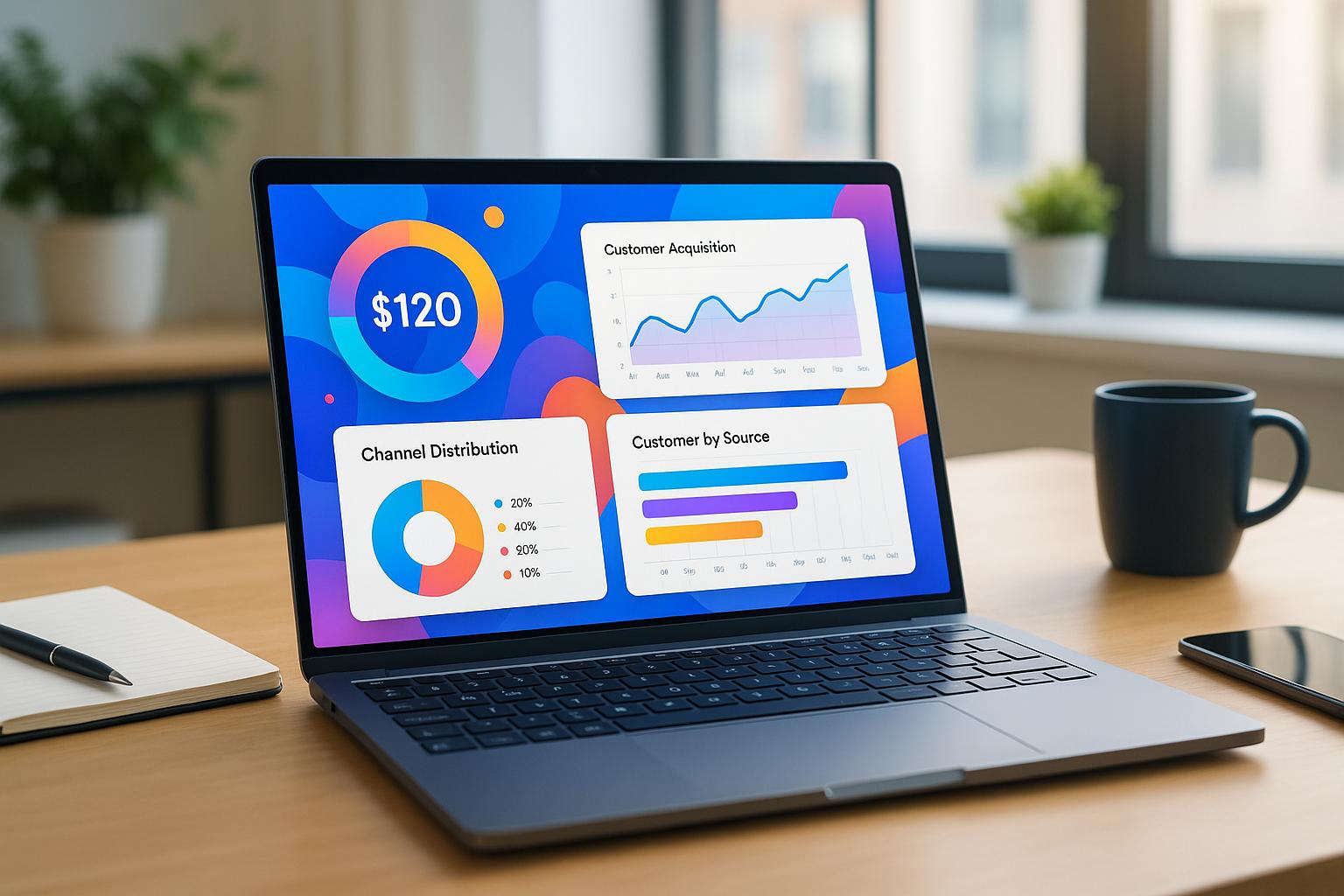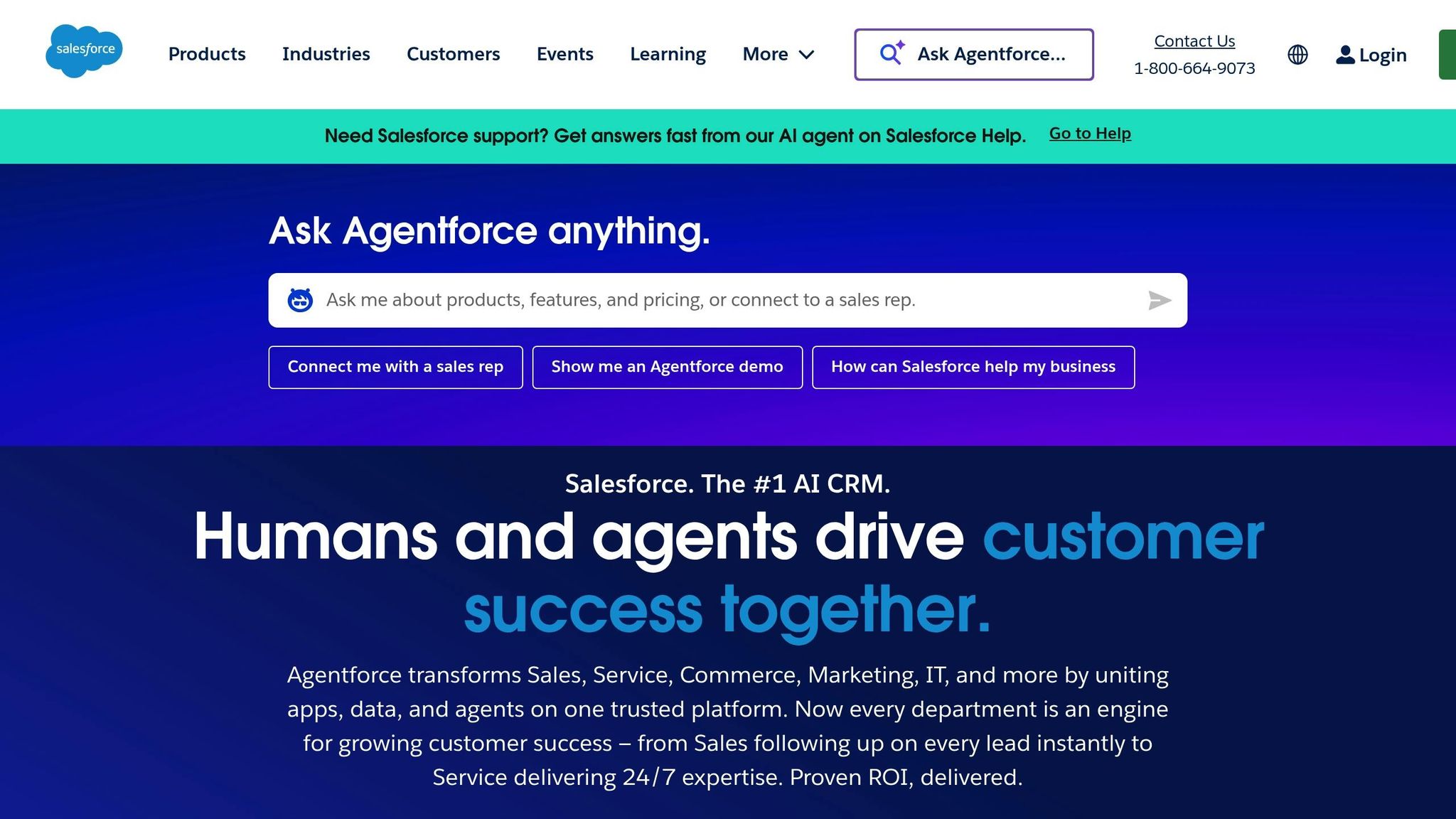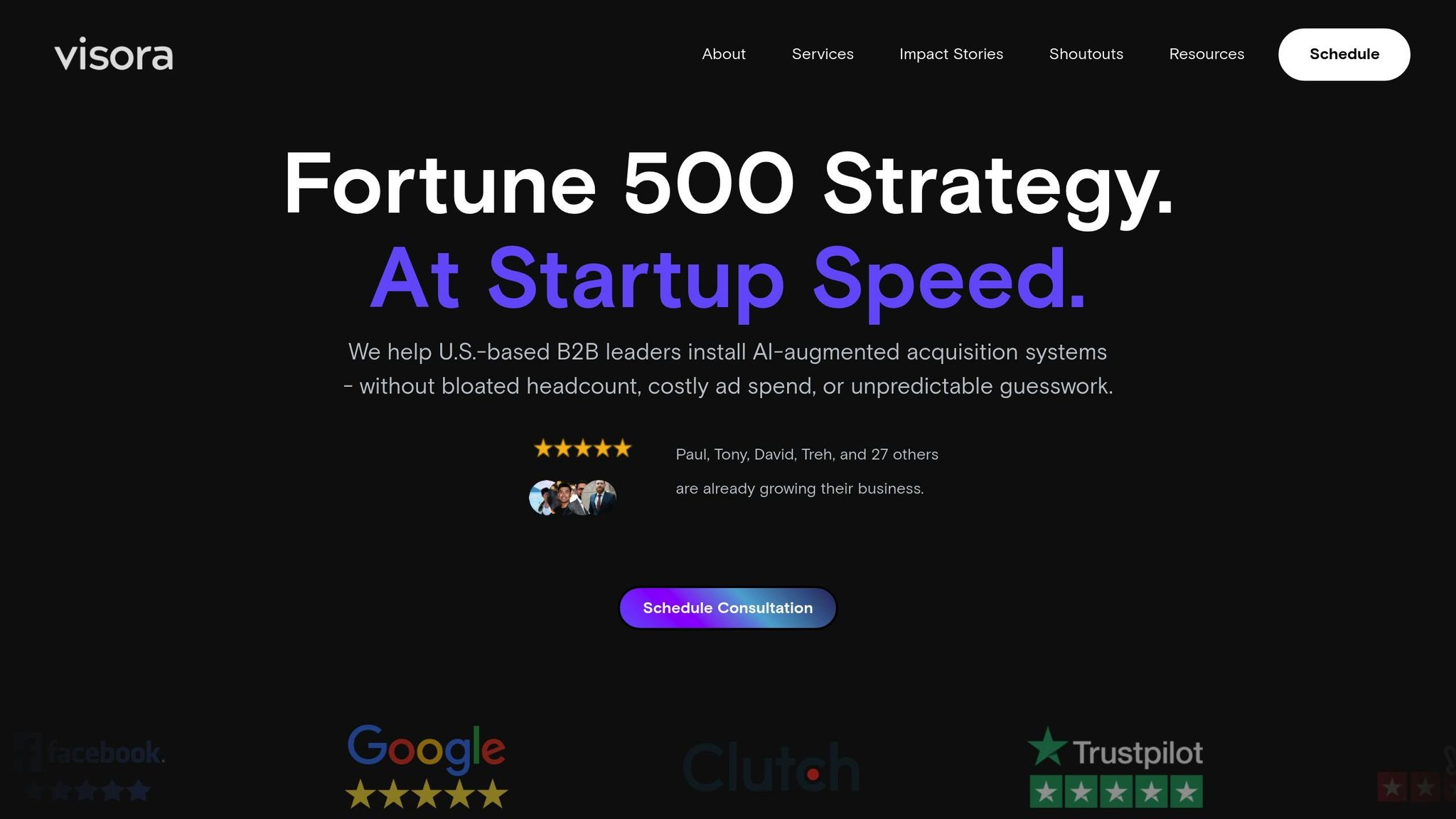
Customer acquisition costs (CAC) are rising, especially in B2B sectors like financial services and real estate, where long sales cycles and selective buyers create unique challenges. To combat this, integrating CRM systems with attribution tools offers a solution by tracking customer interactions and identifying the most effective touchpoints.
Here’s a breakdown of three tools that help businesses reduce CAC:
For businesses with complex sales cycles, AI-driven attribution offers deeper insights into buyer behavior, enabling better resource allocation and lower acquisition costs. Choosing the right tool depends on your industry, budget, and need for speed in implementation.

Salesforce helps businesses track customer interactions using various attribution models, making it easier to manage and optimize customer acquisition costs (CAC).
Salesforce offers three main attribution models:
Next, we’ll take a closer look at HubSpot CRM to see how its attribution features compare.

HubSpot CRM brings a powerful attribution feature that tracks customer interactions across various channels, offering insights into marketing performance and customer acquisition cost (CAC) metrics.
HubSpot supports several attribution models, including first-touch, last-touch, multi-touch, and time decay. The multi-touch model is especially useful as it distributes credit across multiple interactions, providing a more comprehensive view of the buyer's journey.
Let’s dive into how these models are seamlessly integrated into HubSpot’s platform.
One of the standout aspects of HubSpot’s attribution capabilities is how easy it is to use. The platform automatically tracks key activities such as website visits, email interactions, social media engagement, and form submissions, requiring little to no technical expertise.
HubSpot’s native integration with tools like Facebook Ads, Google Ads, and LinkedIn further simplifies the process. Campaign data flows directly into the CRM, automatically creating contact records and mapping out the customer’s journey - from their first interaction to the final closed deal.
These features set the stage for optimizing CAC, which we’ll explore next.
HubSpot’s attribution reporting is a game-changer for reducing CAC. The platform’s Sources Report provides a detailed breakdown of lead generation and customer acquisition by channel, analyzing both the volume and quality of leads from each source.
With the Campaign Analytics tool, businesses can track revenue back to specific campaigns. This enables marketing teams to calculate accurate CAC figures for different efforts, helping them reallocate budgets to high-performing channels while cutting spending on underperforming ones.
HubSpot’s Attribution Report dashboard offers real-time insights by calculating metrics like cost per lead, conversion rates, and revenue per channel. This eliminates the need for manual data crunching.
Additional features like automated lead scoring and workflow automation help prioritize prospects based on their engagement across multiple channels. The Revenue Attribution tool ties marketing activities directly to closed deals, offering clear ROI calculations for each channel. This data feeds into customizable dashboards, allowing marketing and sales teams to refine their acquisition strategies on the fly.

Visora brings together AI-powered growth tools and multi-channel tracking, specifically tailored for B2B leaders in industries like real estate, financial services, and professional services.
Visora's Trifecta Program streamlines the integration process by combining three core components: the B2B Vortex Funnel, AI-Augmented Appointment Setting, and DD Strategy Consulting. By delivering these in a unified system, Visora eliminates the hassle of juggling multiple platforms and attribution tools.
Unlike traditional CRMs, which can take months to implement, Visora's system is up and running in just 12 weeks. It automatically captures intent signals across various touchpoints, ensuring no lead goes unnoticed.
The AI-driven tools take care of data collection and attribution, minimizing the workload for marketing and sales teams. This automated system not only saves time but also ensures accurate tracking of customer journeys, laying the groundwork for a more efficient attribution process.
Visora takes a fresh approach to attribution, focusing on buyer-intent signals rather than relying on outdated touchpoint models. The system tracks key decision-makers - like C-suite executives and high-net-worth individuals - across multiple channels simultaneously.
By capturing interactions from direct outreach, content engagement, and referrals, Visora provides a comprehensive view of the entire acquisition funnel. This is especially useful for B2B sales cycles, which often involve multiple stakeholders and lengthy decision-making processes.
The AI component analyzes behavioral patterns to pinpoint the most effective attribution paths for each industry. This allows businesses to forecast more accurately and allocate budgets based on actual conversion data. Visora’s attribution methodology supports precise decision-making, aligning with long-term growth objectives.
Visora’s integrated system delivers measurable reductions in customer acquisition costs (CAC). The platform has generated over $70 million in pipeline across more than 30 partners, with clients seeing an average pipeline boost of $150,000.
By focusing on qualified appointment setting, Visora has facilitated over 2,000 calls with decision-makers, significantly improving conversion rates. This targeted strategy reduces wasted spending on unqualified leads and accelerates the sales cycle.
Clients also benefit from reduced reliance on high ad spend, referrals, and large sales teams. With AI managing much of the lead qualification and nurturing process, businesses can scale without the typical cost increases, resulting in a lower cost per qualified opportunity.
Visora’s real-time dashboards and automation tools make it easy to track key metrics like pipeline velocity and cost per acquisition, enabling businesses to fine-tune strategies on the fly.
The AI-Augmented Appointment Setting feature automatically scores and prioritizes leads based on intent signals and engagement patterns. This reduces the time spent on manual qualification while improving the quality of leads passed to sales teams.
The system adapts to industry-specific buying behaviors and keeps prospects engaged throughout extended sales cycles. Its analytics provide real-time insights into ROI, acquisition costs, and pipeline progression, empowering B2B leaders to make informed adjustments and optimize performance.
When it comes to optimizing CAC and driving growth, each solution brings its own set of strengths and weaknesses. Here's a closer look at how Salesforce CRM, HubSpot CRM, and Visora's Integrated Solution stack up.
Salesforce CRM stands out for its ability to handle enterprise-level customization and scalability. Its robust reporting tools and third-party integrations make it a strong option for tracking attribution. However, the platform comes with a hefty price tag - both in terms of upfront investment and ongoing maintenance. Implementation can take anywhere from 6–12 months, delaying any immediate return on investment (ROI).
HubSpot CRM with Attribution offers a more budget-friendly starting point, thanks to its freemium model and intuitive interface. Its integrated automation features make deployment faster and smoother, particularly for small and mid-sized businesses, which often see quicker wins. On the flip side, HubSpot has limited customization options, and as businesses scale, they may encounter constraints. Advanced attribution features are locked behind premium tiers, which can push costs higher over time.
While HubSpot is known for its ease of use, Visora's Integrated Solution takes a different approach by offering industry-specific precision through AI-driven insights. With a 12-week implementation timeline, it significantly reduces time-to-market compared to traditional systems. The platform has delivered tangible results, generating over $70 million in pipeline across 30+ partners and boosting average pipelines by $150,000. Its focus on buyer-intent signals provides more accurate attribution for the complex sales cycles typical in B2B environments.
| Feature | Salesforce CRM | HubSpot CRM | Visora's Solution |
|---|---|---|---|
| Implementation Time | 6–12 months | 2–4 months | 12 weeks |
| Industry Focus | General purpose | General purpose | B2B/Real Estate/Financial Services |
| Attribution Model | Multi-touch | First/Last touch + Multi-touch | AI-powered buyer-intent signals |
| Automation Level | Manual setup required | Moderate automation | AI automation |
| Pipeline Results | Variable outcomes | Variable outcomes | $150K average increase |
| Qualified Calls Generated | Variable outcomes | Variable outcomes | 2,000+ qualified calls |
| Cost Structure | High upfront + ongoing | Freemium to premium | Performance-based |
That said, Visora's solution isn't without its drawbacks. Its specialized focus on industries like B2B, real estate, and financial services means companies outside these sectors might not see the same level of benefits. Additionally, businesses that prefer full control over CRM customization may find the AI-driven automation limiting, especially compared to the flexibility offered by Salesforce.
Traditional CRMs often struggle in complex B2B sales environments, where purchasing decisions involve multiple stakeholders over long periods. Visora's buyer-intent approach addresses this challenge but requires businesses to place trust in AI-driven insights rather than manual attribution models they can directly control.
Cost predictability is another key consideration. Salesforce's licensing and customization costs can escalate quickly, while HubSpot's tiered pricing becomes increasingly expensive as businesses require more advanced features. Visora's performance-based pricing aligns costs with results, which can be appealing, but it may lack the transparency some organizations need for precise budget planning.
Choosing between a CRM and an attribution solution boils down to matching your business needs with implementation timelines and industry-specific demands. For B2B leaders aiming to fine-tune customer acquisition costs, the data offers clear guidance on what works best.
Salesforce CRM is ideal for large enterprises managing intricate, multi-department operations. It excels in tracking attribution across numerous touchpoints, making it great for complex sales environments. However, its high cost and prolonged setup period can delay a return on investment, which might not suit businesses needing faster results.
On the other hand, HubSpot CRM provides a more accessible option with quicker deployment. With a 2–4 month implementation window and a freemium entry point, it’s appealing for businesses seeking a faster start. But as companies grow, the need for premium features can drive costs higher than anticipated, potentially catching some off guard.
For industries like real estate syndication, investor relations, commercial real estate, and financial services, Visora stands out. Its 12-week implementation timeline caters to businesses that need immediate results while significantly reducing customer acquisition costs. This makes it a strong choice for organizations seeking both speed and measurable outcomes.
To make the right decision, assess your sales cycle complexity, available technical resources, and the timeline for achieving ROI. Companies that align these factors with their CRM or attribution solution tend to outperform those swayed by brand recognition or upfront costs alone.
One critical takeaway for B2B leaders: generic CRMs often fail to capture the complexity of nuanced buyer behaviors in extended sales cycles. When your deals involve multiple stakeholders and long timelines, traditional attribution models like first-touch or last-touch often miss crucial conversion insights. AI-powered systems, however, can uncover these overlooked behaviors, providing a more comprehensive view of the buyer journey.
The most successful B2B leaders understand that integrating CRM and attribution tools creates scalable, predictable acquisition systems. These systems reduce reliance on referrals and high advertising costs while paving the way for sustainable revenue growth.
Visora takes buyer behavior tracking to the next level with its AI-powered attribution technology. By using machine learning, it analyzes customer interactions as they happen, adapting in real-time to provide a clearer picture of the buyer's journey. Unlike traditional CRM systems that stick to rigid rules or preset frameworks, Visora evaluates every touchpoint across multi-channel paths, delivering insights that are both precise and actionable.
This ability to adjust on the fly means marketing efforts are credited more accurately, enabling businesses to make smarter, data-informed decisions. The result? Lower customer acquisition costs and improved growth. Where traditional models often oversimplify the complexity of buyer journeys, Visora’s AI tools continuously evolve their understanding of customer behavior, ensuring businesses achieve better outcomes.
When choosing a platform to manage customer acquisition costs in a B2B setting, it’s essential to weigh factors like your company’s size, budget, and the complexity of your sales processes. Visora is a notable option, offering AI-powered growth strategies, customized sales funnels, and multi-channel attribution tools - all aimed at helping businesses cut costs while achieving steady growth.
For companies prioritizing automation, intent-based approaches, and quick implementation, Visora’s tailored solutions could be a strong match. If advanced CRM systems and data-driven insights are what you’re after, it’s important to assess how these tools align with your specific business objectives to make the best decision.
Visora's solution offers flexibility, making it a powerful tool for industries such as retail, healthcare, and manufacturing. By utilizing data-driven insights, businesses in these sectors can refine their marketing strategies and streamline operations for better efficiency.
That said, implementing the solution isn't without its hurdles. Companies might face challenges like aligning with industry-specific regulations (think data privacy laws), tailoring workflows to suit unique sector demands, and managing the varying levels of digital readiness within organizations. While these factors can impact both the pace and success of deployment, careful planning can help businesses unlock the full potential of Visora's tools.